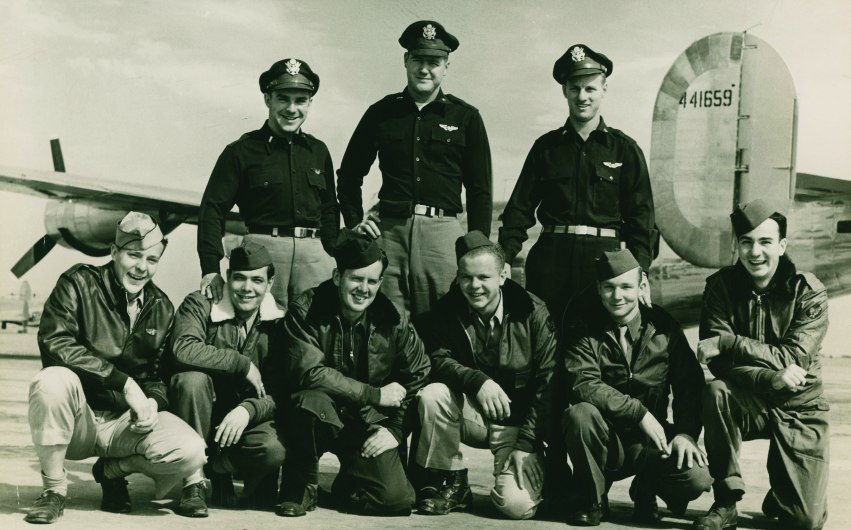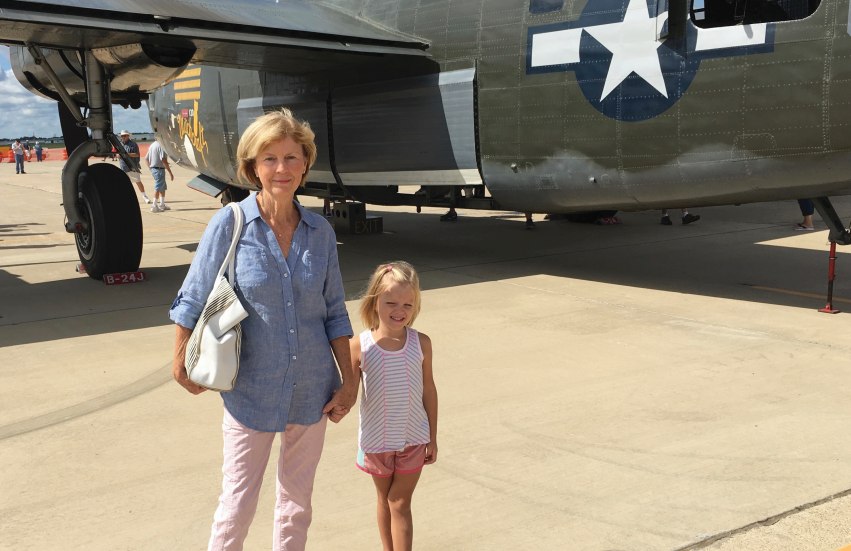War and Remembrance, Then and Now

The year was 1945, and the war in Europe was almost over. It would officially end on May 8, and soldiers were beginning to return home. Here in Peoria, my family had been waiting for this time, waiting for the return of my father and his two brothers.
Our families lived in a part of Peoria called Averyville, and that neighborhood formed the landscape of my father’s life growing up—and the life of my mother’s family as well. My grandparents’ homes were just a few blocks apart from each other. Home, school, work and play, all nestled closely together like the families living there. There was a neighborhood grocer across the street, a library three blocks away, and the Averyville Baptist Church, which stood on the corner across from the house I lived in. Kingman School was close by, and the banks of the Illinois River were within walking distance.
My mom and I were part of a close extended family from the very beginning—living with her parents, my grandparents, while my father was overseas. Like so many other women with absent husbands and sweethearts during the war, she went to work, filling critical vacancies left by the men called into service, and providing for her family at home. My grandparents made a home for all of us, taking care of me and many others in our family.
It was wartime, and shortages meant changes in everyone’s life. The military needed uniforms, so the hems of women’s skirts went up, the belts on their dresses got skinnier, and pleats became fewer. Silk and nylon stockings were needed for parachutes instead of stockings, and the cuffs of men’s pants went out of fashion, while suit lapels got narrower. Food was rationed, along with gasoline, tires, beer, cigarettes and a lot more. During that difficult time, families on the home front were waiting, hoping for an end to the separations, planning for the future, praying for their soldiers so far away. Happy endings were a part of some stories, but not all.

Tragedy, Victory, Survival
A series of tragic events runs through the story of my other grandmother, my father’s mother. In February of 1930, her oldest child Thomas drowned at the age of 15 along with his cousin Frank, who had tried to rescue him when their boat capsized in the Illinois River. The boys were gathering wild cattails for a school play. Four years later, her husband William, only 41 years old, died of tuberculosis after a long stay in a sanitarium. She was 38. Another four years after that, on a hot summer day in July of 1938, her 15-year-old son Floyd was floating with friends on the same river and drowned, as his identical twin, Lloyd, and younger brother Ralph looked on helplessly.
Just a few years later, Grandma said goodbye to three of her four remaining sons as they volunteered for service and shipped overseas—one in the Army Air Corps, one in the Marines, and one in the Army. She lost two of those sons, Leonard and Ralph, in March of the same year. The third son, Lloyd, returned safely, and made Peoria his home for the rest of his life.
Ralph was a tank commander in Patton’s Third Army. He was killed on March 16, 1945—the last to die in the 778th Tank Battalion. He left behind a young wife and an infant son. My father, First Lieutenant Leonard J. Crandell, was the pilot of a B-24J Liberator, 8th Air Force, stationed at Shipdham Airfield in England with the 44th Bomb Group. He flew 21 missions over Germany. He died eight days after his brother Ralph, on March 24. The two brothers never knew of each other’s fate.
I always knew how my father died. The short story was that his plane was shot down and crashed somewhere in Germany. His death defined who he was to me for many years, little more than a series of snapshots and sepia photographs. I now know more of the story. Leonard’s final flight was a low-level mission during Operation Varsity, the largest airborne operation of World War II, in support of Field Marshall Montgomery’s thrust across the Rhine, dropping supplies to British paratroopers. His plane, “Kay Bar,” was hit by anti-aircraft fire from the ground, crashed and exploded on impact. From a newsletter of the 44th Bomb Group Reunion, October 2003: March 24 was a singular moment in history. It was the day the Allies would cross the Rhine River, bringing the war onto the German homeland. 240 Liberators from the 8th Air Force, 27 from the 44th BG, set forth...
After my father’s death, a sort-of lost and unspoken link in memory and in time followed. There must have been so much grief and readjustment swirling around me, so many injured souls attempting to find a path through it all. Families picked up and carried on. It was the way of things in the years during and following the war, and it was the chosen course of survival for so many.

The Turns of History
That was 75 years ago, and this year, 2020, marks the 75th anniversary of the end of World War II in Europe—a war that took 60 million people, including 400,000 Americans. Many were fathers, and one of them was mine. This was to be a year of commemorations and special celebrations all over the world, a time to remember those men and women of the “Greatest Generation,” and to honor their sacrifices and contributions to our freedom, and the life we live today.
2020 was barely underway, however, when history took a new turn, and the focus on the past got lost in the urgency of the present. A different kind of war is waging right now in our country, and along with that, a different kind of conflict. This time, the battlefield is here. There are no bombs falling from the sky or tanks roaring into our towns. A global pandemic was joined by the conflict of racial strife. As we deal with uncertainty, loss, division and fear, it’s not difficult to see the similarities to living in 1940s wartime.
“Normal” life has turned upside-down everywhere, forcing daily adjustments to how we live. We are dealing with uncertainty like never before, as well as painful separation from those we love. We are experiencing losses, conflicts in our communities, and fear for those we love and for our future. Yet while the negative similarities are many, so are the positives. We are fighting back. We are standing up for each other. Heroes are emerging everywhere.
The Greatest Generation is slowly disappearing from this world, but we should look back at them. They showed us the way through times of trouble. They set an example that brought this country around, and raised it back up. They exemplified what real heroes are—not only on the battlefields where they fought and died, but back at home, after the war ended. The ones who came home wasted no time getting back to the business of rebuilding, living and loving. The ones who didn’t return left a legacy for all of us to know and remember that a great sacrifice had been offered. Remember them we must. When freedom hung in the balance, it was our people, leaving home and family for the unknown, who tipped the scales for victory.

Light of Freedom
“To the generation of Americans whose unwavering valor and sacrifice returned the Light of Freedom to the world.”—National World War II Memorial Dedication, May 29, 2004
Somewhere between that Greatest Generation and the Baby Boomers, there exists a generation of WWII war orphans—children born just before, during and even after the battles were fought. I am just one of the thousands of children who never knew their fathers. As wives, mothers, fathers, sisters, brothers and friends were left behind to pick up the pieces of their lives, shattered by war, we orphans were destined to live out our lives with many missing pieces.
I discovered AWON, the American WWII Orphans Network, as I was doing research for a memoir about my father. AWON was founded in 1991. The members of this organization welcome all family members who lost an American serviceman in World War II. They continue their work to educate the public, support numerous memorials and American cemeteries overseas, and to keep learning about the service of our lost fathers. As individuals and as a group, we honor their memory and speak their names.
The lessons of war are hard ones, yet the past can teach us, it can inspire us, and it can show us the way to a better future… if we only look and remember. PM
Janice Crandell Powers is the daughter of 1st. Lt. Leonard J. Crandell and author of Pieces of Us—a journey of discovering the lost pieces of two lives, a father and a daughter, losing each other too soon, yet finding each other after all. It is available at Amazon.com and stonewellgardensart.etsy.com. She can be reached by email at stonewellgardens@gmail.com.
- Log in to post comments

